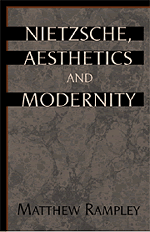Book contents
- Frontmatter
- Contents
- List of Abbreviations
- Acknowledgements
- Introduction
- 1 Truth, Interpretation and the Dialectic of Nihilism
- 2 Nietzsche's Subject: Retrieving the Repressed
- 3 Laughter and Sublimity: Reading The Birth of Tragedy
- 4 Wagner, Modernity and the Problem of Transcendence
- 5 Memory, History and Eternal Recurrence: The Aesthetics of Time
- 6 Towards a Physiological Aesthetic
- 7 Art, Truth and Woman: The Raging Discordance
- 8 Overcoming Nihilism: Art, Modernity and Beyond
- Notes
- References
- Index
3 - Laughter and Sublimity: Reading The Birth of Tragedy
Published online by Cambridge University Press: 18 March 2010
- Frontmatter
- Contents
- List of Abbreviations
- Acknowledgements
- Introduction
- 1 Truth, Interpretation and the Dialectic of Nihilism
- 2 Nietzsche's Subject: Retrieving the Repressed
- 3 Laughter and Sublimity: Reading The Birth of Tragedy
- 4 Wagner, Modernity and the Problem of Transcendence
- 5 Memory, History and Eternal Recurrence: The Aesthetics of Time
- 6 Towards a Physiological Aesthetic
- 7 Art, Truth and Woman: The Raging Discordance
- 8 Overcoming Nihilism: Art, Modernity and Beyond
- Notes
- References
- Index
Summary
Nietzsche's critiques of metaphysics and of the metaphysical subject are intimately linked with the question of modernity and the concomitant emergence of nihilism. As I suggested earlier, Nietzsche's philosophical critique is undertaken with a view to what he predicted would be its catastrophic cultural consequences. However, his assault on metaphysics, together with the substitution of the notion of interpretation, constitutes only one aspect of the overcoming of modern culture. The second is the restitution of an aesthetic culture; it is art that constitutes interpretative activity above all, and it is the artist that embodies the characteristics Nietzsche projects onto the Übermensch. In this respect Nietzsche's emphasis on the necessity for aesthetic revolution throws up important parallels with Friedrich Schiller, towards whom he displayed some considerable ambivalence. In On the Aesthetic Education of Man in a Series of Letters Schiller sees art as both reconstructing the divided and alienated subject of modernity and functioning as the medium through which modern man can express his freedom: ‘it is only through beauty that man makes his way to freedom.’ Moreover Schiller also shares Nietzsche's disdain for the common mass: aesthetic revolution is the privilege of the few.
While the importance of art in Nietzsche's work is universally recognised, attention tends to focus solely on The Birth of Tragedy. Being the only full-length treatment of art in Nietzsche's oeuvre, the text tends to dominate interpretations of the subject. It is a perfectly comprehensible state of affairs, inasmuch as his later writing on art remains in many respects quite scattered and unfocused.
- Type
- Chapter
- Information
- Nietzsche, Aesthetics and Modernity , pp. 78 - 109Publisher: Cambridge University PressPrint publication year: 1999



